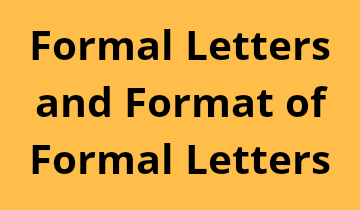We live in a world where communication is backed by technology. Technology has grabbed a major chunk of communication modes and models these days.
E-mails, texts, etc have become one of the most preferred mediums of our daily life communication.
However, letters still have a certain presence and usability in our society.
Especially in case of formal letters that are written to authorities or professional and business contacts, because they usually have to stay on record.
It is important for us to learn the correct format and language of formal letters.

Formal Letters
A formal letter is written in a polite and respectable language and follows a certain structured format.
Such letters are written for professional communication with a notable purpose to officials, authorities, dignitaries, co-workers, seniors, etc and not to entertain personal contacts, friends or family.
Certain conventions must be followed while drafting formal letters.
So let us take a look at a sample format of a formal letter.
Format of a Formal Letter
As we said, a formal letter must follow certain guidelines and regulations.
Such a structured format helps in relaying the information in a professional manner.
It must be understood that there are various formats for formal letters that people follow for professional communication.
The one explained here is one of the most commonly used sample format for formal communication these days.
Sender’s Address
The sender’s address is generaly put on the top right-hand corner of the page.
The address should be accurate and completely noted in case the recipient of the letter wishes to get in touch with the sender for further communication.
Date
The sender’s address is followed by the date just below it, i.e. on the right-hand side of the page.
This is the date on which the letter is being written.
It is important to write date in formal letters as they are often kept on record and maintained accordingly.
Receiver’s Address
After leaving some space we write the receiver’s address on the left-hand side of the page.
To write “To” above the address depends completely on the writer’s preference.
Make sure you write the official title/name/position etc of the receiver, as the first line of the address.
Greeting
This is where you greet the person you are addressing the letter to.
Bear in mind that it is a formal letter, so the greeting must be respectful and not too personal or frank. The greetings used in formal letters mostly are “Sir” or “Madam”. In case you know the name of the person, the salutation may also be written as “Mr. XYZ” or “Ms. ABC”. But it is advised not to address them only by their first name. Either it must be the full name you write or only their last name.
Subject
After the salutation or greeting comes the subject of the letter.
In the centre justification of the line write ‘Subject’ followed by a colon. Thereafter we need to sum up the purpose of writing the letter in one line. This helps the receiver understand the subject of the letter at one glance.
Body of the Letter
This is where the main content is written and it is the most important part of the letter.
It can be divided into three parts or two parts if the letter is written in brief. The purpose and intent of the letter must be made clear in the first paragraph itself.
The tone of the content must remain formal throughout the letter.
Do not use any frank language or careless attitude.
Another point to be kept in mind is that the letter should be clear, concise and to the point. And always be respectful and polite in your language, no matter what the subject of your letter is.
Closing the Letter
At the end of your letter, a complimentary losing is written. The words “Yours Truly” or “Yours Sincerely” are written on the right-hand side of the paper. Generally, we use the later if the writer knows the receipent.
Signature
Here, you put your signatures. And then write your name in block letters below the signature. That’s for the recipient to confirm who is sending the letter.
Tags- Formal letters, Format of Formal Letters.